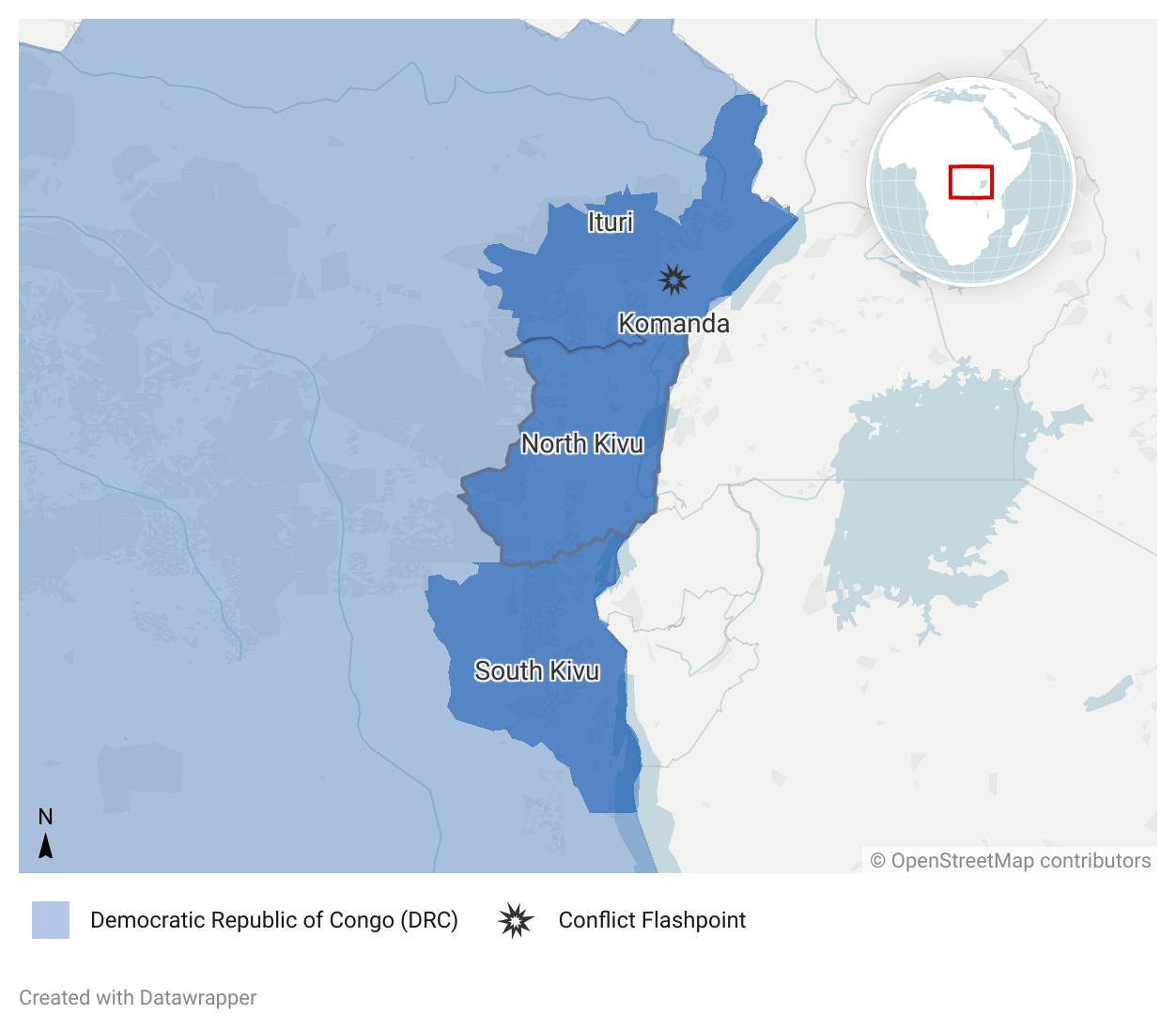A Fragile Ceasefire: Terror Threatens DRC-Rwanda Peace Agreement
Tom Hayward | 13 August 2025
Summary
The Allied Democratic Forces (ADF), a militant group operating in the Democratic Republic of Congo (DRC), carried out an attack on a Catholic Church, killing 36 civilians.
The ADF’s attack comes as the DRC and Rwanda take steps to implement a peace deal signed in June 2025, with violence threatening to derail the agreement’s implementation.
Heightened militant activity will likely intensify throughout 2025, undermining the DRC-Rwanda peace deal and drawing in greater foreign military involvement from regional actors such as Uganda.
On 26 July 2025, the Allied Democratic Forces (ADF) attacked a Catholic Church in Komanda, Irumu district, killing at least 38 in the church and five more in a nearby village. The attack is one of several recent assaults launched by the ADF, indicative of a major resurgence. The incident also comes after the DRC signed a US-brokered peace agreement with Rwanda and Qatari-mediated agreement with the Rwanda-backed M23 rebel group aimed at ending months of conflict. The agreement was reached after DRC President Félix Tshisekedi proposed granting the US access to critical minerals, including cobalt and lithium, in return for a security agreement.
The ADF is an Islamist militant group formed in Uganda in 1995 by a coalition of rebel forces. It received support from the Sudanese government and backing from the DRC governments aiming to subvert Rwandan and Ugandan influence in the DRC. The ADF is one of over 100 rebel groups operating in the DRC. In 2019, the group declared allegiance to the Islamic State (IS), and is now part of the Islamic State - Central African Province (IS-CAP). IS-Central provides financial support and weapons to the ADF, enabling its campaign of terror in eastern DRC. The group’s most notable attack to date was its assault in 2020 on a jail in Beni, which led to the escape of over 1,300 prisoners, including ADF members. Greater IS activity in the DRC follows the loss of its caliphate in 2019, with regional instability in East Africa offering an opportunity to establish a foothold, in addition to existing presences in the Sahel and West Africa. IS activity has also expanded in the Sahel region, where political instability and poor economic conditions have created fertile ground for recruitment. IS has aspirations to link its territories in Nigeria and the Sahel, an ambition that is unlikely to be realised in the immediate future but which demonstrates the group’s growing assertiveness on the continent.
Enhanced ADF activity has capitalised on the government’s conflict with M23, which diverted much of the DRC’s military resources. In January, M23 launched lightning offensives and seized territory in eastern provinces of North and South Kivu, with support from the Rwandan government and its troops on DRC soil. The Congolese Armed Forces’ (FARDC) response has exacerbated a security vacuum in Ituri and parts of North Kivu, enabling the ADF to escalate attacks on the civilian population. Since early 2025, this has driven mass displacement in Kivu and Ituri, with the UN also warning of restricted humanitarian access. The ADF’s resurgence further stretches the FARDC and threatens to complicate the implementation of ceasefire provisions outlined in the June 2025 peace deal with Rwanda. Operational strains on the FARDC will create openings for both M23 and local militias. It also raises the risk that external militaries will act unilaterally to exploit their own interests on Congolese soil. Since November 2021, 4,000 Ugandan soldiers have been deployed into the DRC under Operation Shujaa to confront the ADF. There is some concern in Kinshasa that Uganda’s military operations are also driven by economic interests, with its troops expanding into territory not affected by ADF attacks. Meanwhile, Washington hopes that the implementation of the DRC-Rwanda peace deal will enable access to some of the DRC’s USD 25t in mineral reserves.
MONUSCO Photos/CC BY-SA 2.0
Forecast
Short-term (Now - 3 months)
Increased frequency of attacks by the ADF over the coming months is highly likely, as the group seeks to capitalise on the DRC military’s focus on M23.
Such attacks are likely to destabilise eastern DRC and erode government control in Ituri and Kivu as the ADF consolidates control of remote areas.
Medium-term (3-12 months)
Continued ADF violence is likely to force Kinshasa to deploy additional forces to the Ugandan border, weakening confidence in the DRC-Rwanda peace agreement and, for Rwanda, justifying a continued security presence on Congolese soil.
It is a realistic possibility that ADF and other rebel group activity could result in the collapse of the DRC-Rwanda peace agreement.
Long-term (>1 year)
An emboldened ADF and other IS-funded militant groups in East Africa will highly likely continue to undermine regional security, seeking to exacerbate existing conflicts.
It is a realistic possibility that a stronger foothold in rural areas will enable the ADF to launch bolder and more frequent attacks in urban areas, presenting a new scale of threat to the Kinshasa regime.



